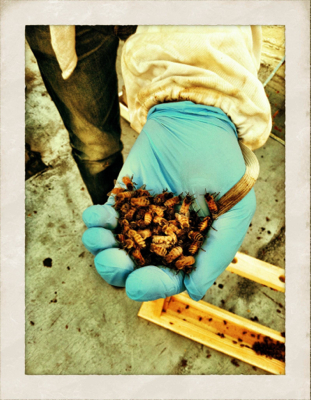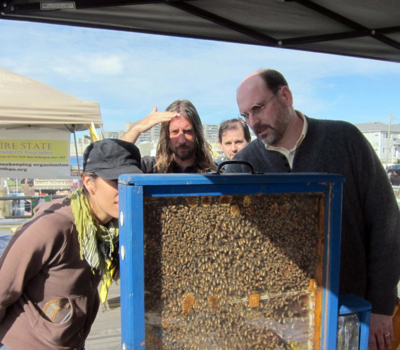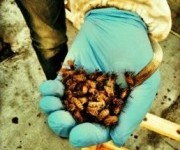 Photo: Shelley Fank
Photo: Shelley Fank
This fall marks the first full year of legal honey harvesting in New York City — and oh how sweet it is.
In March of last year, the New York City Board of Health and Mental Hygiene took Apis mellifera, the common honeybee, off their list of insects and animals considered too dangerous for city life. As a result, beekeepers registered a record number of hives with the board in 2011. So many, in fact, that local suppliers were unable to meet the unprecedented demand for starter colonies.
Meanwhile, NYC’s hard core “beeks” have come out of the closet. Even before legalization, hundreds of outlaws tended hives in the city. Old-timers love to wax nostalgic about illegal hives on the roofs of synagogues, co-ops, and private homes, where hives were disguised as air conditioning units. Tiny New York apartments were home to cabinet-like hives hooked up to plastic tubes to let the bees out through the window to forage for sustenance.
Beekeeping novices and old-schoolers alike came together last weekend to swarm the Rockaway Beach boardwalk in Queens for the First Annual NYC Honey Festival. Organized by the one-acre rooftop farm Brooklyn Grange and hosted by the association of sustainable food vendors that caused a surge of visitors to Rockaway this summer, the festival showed the rest of the city what happens when we lay out the welcome mat for bees — the pollinators that have a role in around 90 different food crops, or around one out of every four bites of food we eat.
 The observation hive at the NYC Honey Festival.Photo: Michael Leung
The observation hive at the NYC Honey Festival.Photo: Michael Leung
Honey Festival participants brought honey from their own NYC hives, while chefs demonstrated honey-centric recipes, and experts spoke on a range of bee-related topics. One of the most popular attractions was the observation hive, where a window allowed a view into the life of an active colony. BoroughBees blogger Tim O’Neal set up the hive, and spent the day answering questions from passers-by.
O’Neal says the event confirmed what he had already begun to suspect: The beekeeping community is expanding and diversifying, virtually overnight. “New York is now host to a huge number of organizations, businesses, and individuals who all keep bees and interact with each other and the wider community in increasingly creative and meaningful ways,” he says.
Not that there aren’t challenges to keeping bees in such a large metropolis. Last summer’s headline-making Red Hook red honey epidemic was traced to bees who had ingested uncontained waste (read: red sugar water) from a nearby maraschino cherry factory.  The NYC Honey Festival. Photo: Tim O’NealSwarming bees have gotten media attention. And the city department that legalized bees is still without a designated bee expert in place, so most beekeepers feel that inspections and regulations are unpredictable at best. Some claim they’ve been slapped with steep fines for arbitrary violations during unannounced inspections, like this man who was fined $2,000 for not watering his bees.
The NYC Honey Festival. Photo: Tim O’NealSwarming bees have gotten media attention. And the city department that legalized bees is still without a designated bee expert in place, so most beekeepers feel that inspections and regulations are unpredictable at best. Some claim they’ve been slapped with steep fines for arbitrary violations during unannounced inspections, like this man who was fined $2,000 for not watering his bees.
Near the end of the summer, a series of city-wide mosquito sprayings caused a buzz on local listservs (the toxins don’t distinguish among flying bugs and can be lethal to unprotected hives). Finally, a rivalry between the city’s two biggest beekeeping associations erupted when a tree was split during Hurricane Irene, revealing a feral (or wild) colony of honeybees; both groups wanted to claim the 30,000- to 40,000-bee hive.
Through all this, however, the drive to keep hives remains clear. And last week’s festival provided an opportunity for solidarity and celebration. “There’s a revolution taking place in Brooklyn and in cities all across the U.S.,” says amateur beekeeper Ross Brown. “People want a stronger, more immediate connection to their surroundings, and many are turning back to the land, even if that ‘land’ is in containers on fire escapes.”



